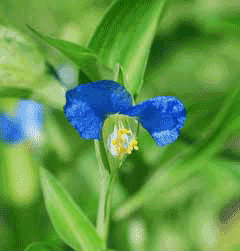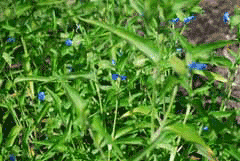 |
|
http://picasaweb.google.com/lh/photo/VeS29FV6_aBXbnMSGiDq3A |
 |
| http://picasaweb.google.com/lh/photo/SFPXKVnLQOFeq-moP6mWMQ |
Translate this page:
Summary
Physical Characteristics

 Commelina coelestis is a PERENNIAL growing to 0.5 m (1ft 8in) by 0.3 m (1ft).
Commelina coelestis is a PERENNIAL growing to 0.5 m (1ft 8in) by 0.3 m (1ft).
See above for USDA hardiness. It is hardy to UK zone 9. It is in flower from July to September, and the seeds ripen from August to October. The species is hermaphrodite (has both male and female organs).
Suitable for: light (sandy) soils and prefers well-drained soil. Suitable pH: mildly acid, neutral and basic (mildly alkaline) soils. It cannot grow in the shade. It prefers dry or moist soil and can tolerate drought.
UK Hardiness Map
US Hardiness Map
Synonyms
Plant Habitats
Cultivated Beds; South Wall. By. West Wall. By.
Edible Uses
Edible Parts: Root
Edible Uses:
Tubers - cooked[2]. Starchy[105]. The plant forms a clump of thin finger-shaped roots about 7 - 10cm long. These are easily harvested, though overall yields are low. The roots have a fairly bland flavour and an acceptable texture[K]. By no means a favourite root crop, but acceptable in small quantities[K].
References More on Edible Uses
Medicinal Uses
Plants For A Future can not take any responsibility for any adverse effects from the use of plants. Always seek advice from a professional before using a plant medicinally.
None known
References More on Medicinal Uses
The Bookshop: Edible Plant Books
Our Latest books on Perennial Plants For Food Forests and Permaculture Gardens in paperback or digital formats.

Edible Tropical Plants
Food Forest Plants for Hotter Conditions: 250+ Plants For Tropical Food Forests & Permaculture Gardens.
More

Edible Temperate Plants
Plants for Your Food Forest: 500 Plants for Temperate Food Forests & Permaculture Gardens.
More

More Books
PFAF have eight books available in paperback and digital formats. Browse the shop for more information.
Shop Now
Other Uses
References More on Other Uses
Cultivation details
Prefers a light well-drained loam with added leafmold and a warm sunny position[42, 111, 190]. Established plants are drought tolerant[190]. A very ornamental plant[1], it is not very winter hardy in Britain so the roots are best dug up in autumn and stored like dahlias in a cool frost free place[1]. When grown in a light well-drained soil and mulched well, the roots usually survive the winter outdoors, at least in the milder areas of the country[111, K]. This plant is very attractive to slugs[K].
References Carbon Farming Information and Carbon Sequestration Information
Temperature Converter
Type a value in the Celsius field to convert the value to Fahrenheit:
Fahrenheit:
The PFAF Bookshop
Plants For A Future have a number of books available in paperback and digital form. Book titles include Edible Plants, Edible Perennials, Edible Trees,Edible Shrubs, Woodland Gardening, and Temperate Food Forest Plants. Our new book is Food Forest Plants For Hotter Conditions (Tropical and Sub-Tropical).
Shop Now
Plant Propagation
Seed - sow March in a greenhouse. The seed usually germinates in 4 - 5 weeks at 20°c[164]. Prick the seedlings out into individual pots as soon as they are large enough to handle and plant out in late spring or early summer after the last expected frosts. Division in early spring. The root clump consists of a number of finger-shaped roots joined together at their tops. When dividing this, it is important to ensure that each division has at least one growing bud at the top[111, K]. Pot up the divisions and grow them on in a greenhouse or cold frame until they are established and then plant them out in late spring, after the last expected frosts[K]. Cuttings during the growing season. These root very easily[200].
Other Names
If available other names are mentioned here
Native Range
NORTHERN AMERICA: Mexico (Baja California Sur, Chihuahua, Coahuila de Zaragoza, Durango, Nuevo León, San Luis Potosí, Sinaloa, Sonora, Tamaulipas, Zacatecas, Aguascalientes, Chiapas, Ciudad de México, Colima, Guanajuato, Guerrero, Hidalgo, Jalisco, México, Michoacán de Ocampo, Morelos, Nayarit, Oaxaca, Puebla, Querétaro, Tlaxcala, Veracruz de Ignacio de la Llave)
Weed Potential
Right plant wrong place. We are currently updating this section.
Please note that a plant may be invasive in one area but may not in your area so it's worth checking.
Conservation Status
IUCN Red List of Threatened Plants Status :

Growth: S = slow M = medium F = fast. Soil: L = light (sandy) M = medium H = heavy (clay). pH: A = acid N = neutral B = basic (alkaline). Shade: F = full shade S = semi-shade N = no shade. Moisture: D = dry M = Moist We = wet Wa = water.
Now available:
Food Forest Plants for Mediterranean Conditions
350+ Perennial Plants For Mediterranean and Drier Food Forests and Permaculture Gardens.
[Paperback and eBook]
This is the third in Plants For A Future's series of plant guides for food forests tailored to
specific climate zones. Following volumes on temperate and tropical ecosystems, this book focuses
on species suited to Mediterranean conditions—regions with hot, dry summers and cool, wet winters,
often facing the added challenge of climate change.
Read More
Expert comment
Author
Willd.
Botanical References
200
Links / References
For a list of references used on this page please go here
Readers comment
© 2010, Plants For A Future. Plants For A Future is a charitable company limited by guarantee, registered in England and Wales. Charity No. 1057719, Company No. 3204567.